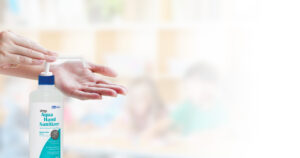All you need to know about hand sanitizers

Hand sanitizers are increasingly popular and with virus outbreaks occurring frequently like the recent MERS-CoV currently happening in Korea, their use have become a common and effective way to prevent infection and the spread of germs. Hand sanitizers are convenient; they don’t require particular settings to install and can be put on table tops or in dispensers to enable everyone to use them. They are also easy to use and offer a quick solution to keep your hands safe. But not all sanitizers are the same. Check our tips to help you choose your hand sanitizer and be fully protected.
Benefit and effectiveness of hand sanitizer
Alcohol based hand sanitizers are proven to eliminate 99,99% of the germs on hands. Once you have rubbed your hands with the product and it has dried, your hands are safe. Hand sanitizers kill bacteria and most viruses, by dissolving the essential proteins of the germs and disrupting their normal cell activity, unlike hand washing with water and soap that only washes germs away. Hand sanitizers are effective against many bacteria, the common cold, flu viruses, as well as fungal infections.
Studies shows that families who use hand sanitizers, saw a lower risk of gastrointestinal and respiratory infections, and infections spread less among the members of the family. Providing hand sanitizer solutions can help increasing hand hygiene adherence necessary in healthcare settings as they offer a quick and easy alternative to hand washing. Adding them in classrooms and office can be a way to reduce absenteeism and sick leaves.
How to choose your hand sanitizer?
There are many hand sanitizers in the market and choosing the right one can be confusing. You need to read the ingredients as they are a determining factor and ensure the effectiveness of the product. Hand sanitizers contain active and inactive ingredients.
Active ingredient consists generally of alcohol. Be sure to choose a hand sanitizer with an alcohol concentration over 60% of the content. Under this amount, the product won’t be powerful enough and you will still carry germs on your hands. Alcohol can be found under different forms; ethyl alcohol, ethanol or isopropanol. It is the central ingredient of hand sanitizers and kills most germs without causing harm to the skin. Whatever alcohol form you choose they are all suitable to ensure safe hands.
In addition to alcohol, inactive ingredients are usually part of the product. These inactive ingredients have different role. They can help for the application of the product and also prevent dryness of the skin. Choosing a sanitizer containing moisturizer agents will minimize irritation. These agents include Aloe Vera, Vitamin E and humectants, such as glycerin. With these ingredients, sanitizing hands turns out to be less drying and gentler for the hands than washing them.
Another ingredient that can be found is chlorhexidine which slows down the development of bacteria in your hands by creating a protective film on your skin, offering a good protection that can last up to 6 hours.
Hand sanitizers can also contain fragrance oils to help lessen the smell of alcohol when applying the product.
Hand sanitizers are usually in the form of Gel or Spray. Both products are equivalent in their effectiveness; the only difference will come from the texture and drying time. A gel alcohol hand sanitizer will take more time than a spray alcohol sanitizer to fully dry.
Can we replace hand washing with hand sanitizing?
Hand sanitizers are efficient at killing germs on hands, but they are not cleaning agents, and so not meant as a replacement, but as an alternative when soap and water are not available. Sanitizers are most effective when used in combination with hand washing. The majority of people don’t wash their hands long enough to completely remove all germs, using hand sanitizer is a good way to ensure a complete protection. Hand sanitizers will not get through fluids and dirt to kill germs. They must be washed away first for the alcohol in the sanitizer to be effective and so, for this situation, hand sanitizers are not a preferred solution. Handwashing with soap and water is recommended in such circumstances.
Sources:
Webmd. 2013. Hand Sanitizers: Do They Help Stop All Germs?. [ONLINE] Available at: http://www.webmd.com/cold-and-flu/news/20130208/hand-sanitizers-germs.
Livestrong. 2014. Ingredients in Hand Sanitizer. [ONLINE] Available at: http://www.livestrong.com/article/164674-ingredients-in-hand-sanitizer/.
Wonderopolis. 2014. Does Hand Sanitizer Really Work?. [ONLINE] Available at: http://wonderopolis.org/wonder/does-hand-sanitizer-really-work/.
NCBI. 2008. Effect of Hand Hygiene on Infectious Disease Risk in the Community Setting: A Meta-Analysis. [ONLINE] Available at: http://www.ncbi.nlm.nih.gov/pmc/articles/PMC2446461/.







